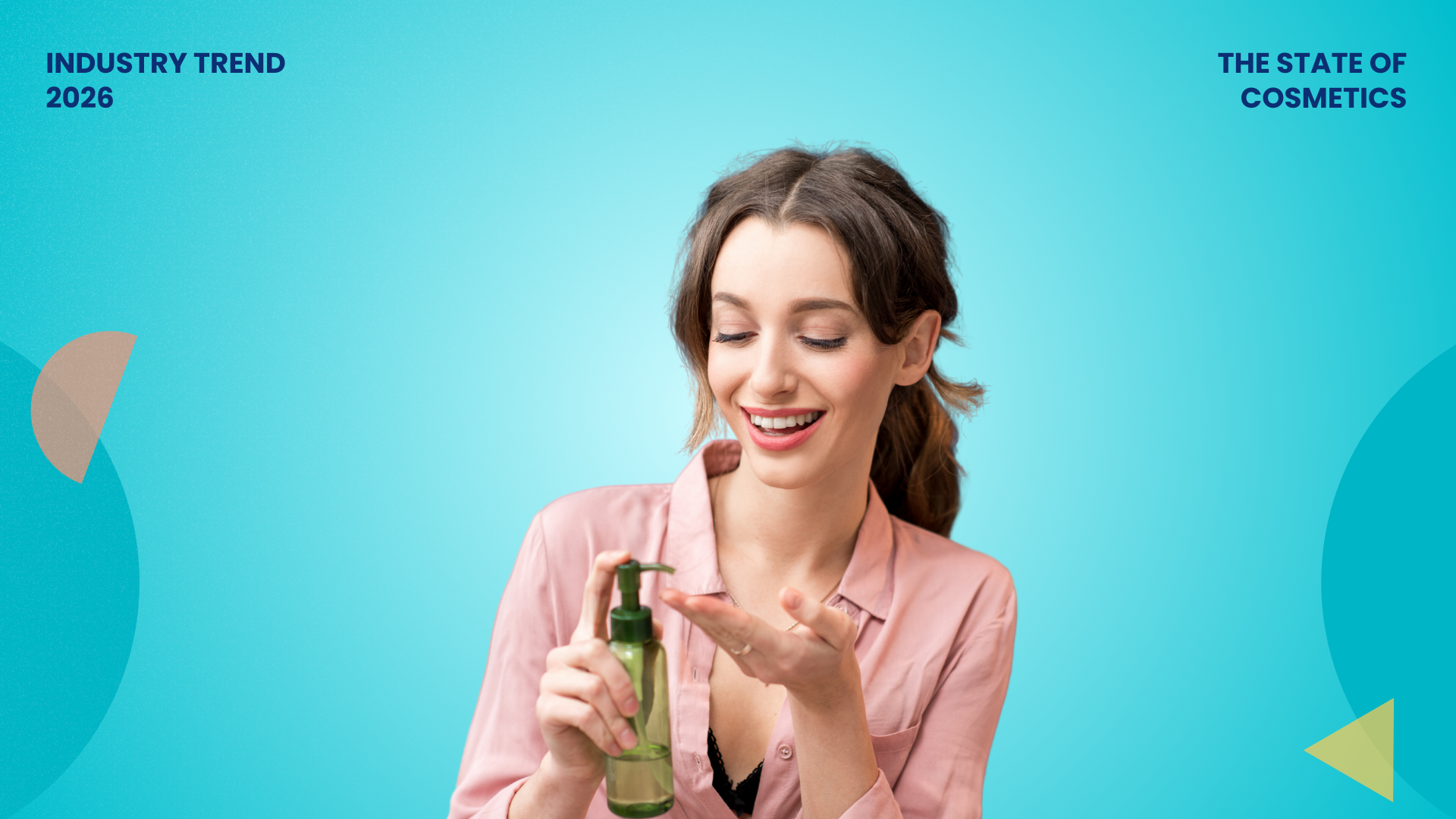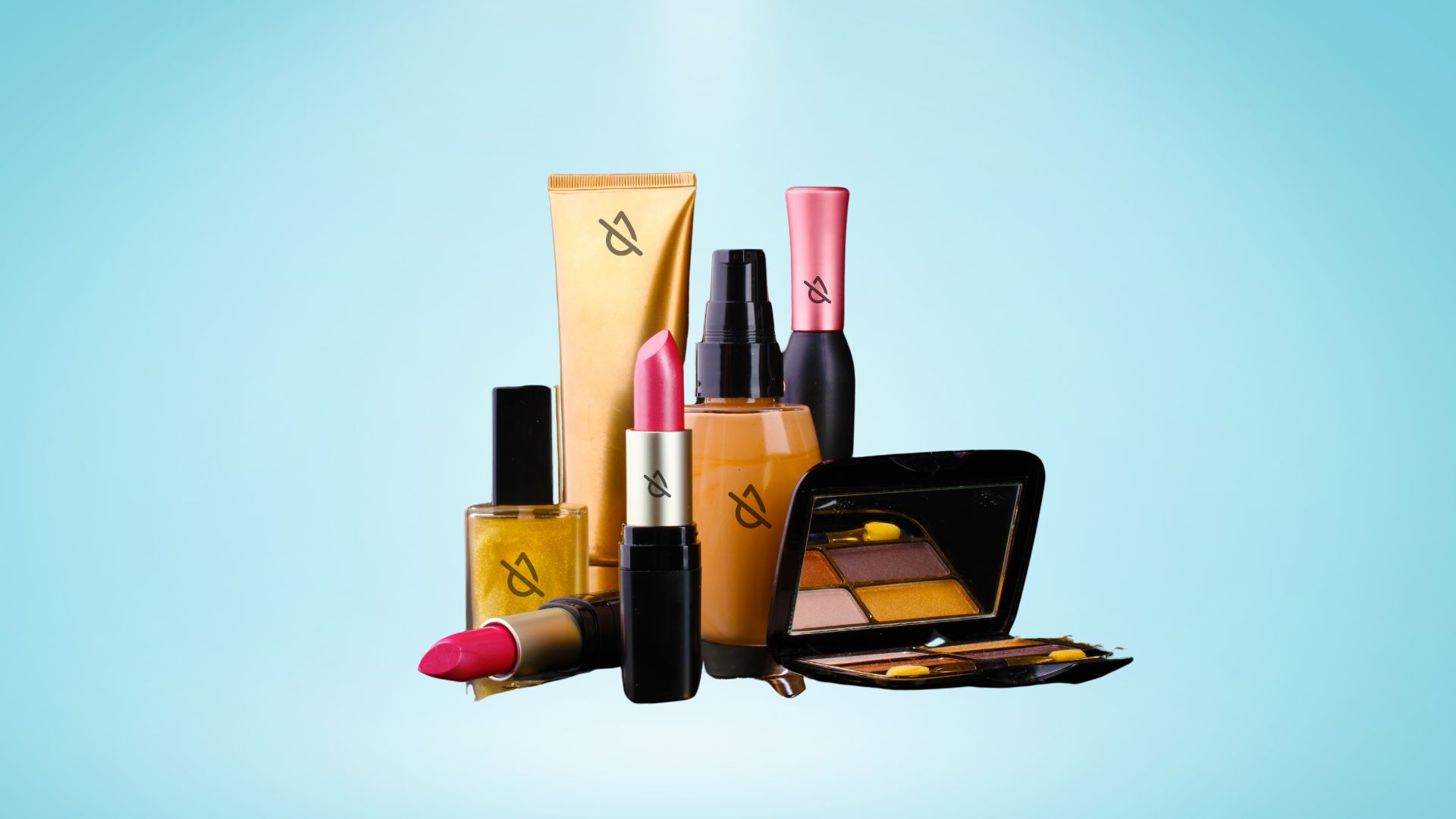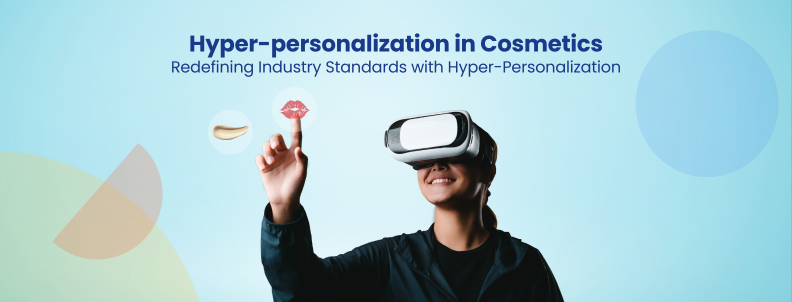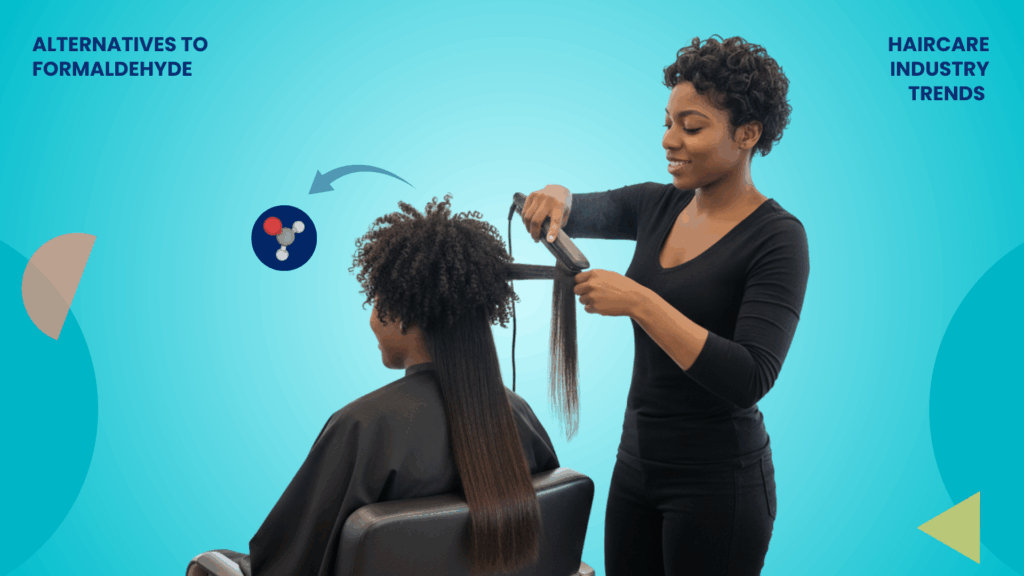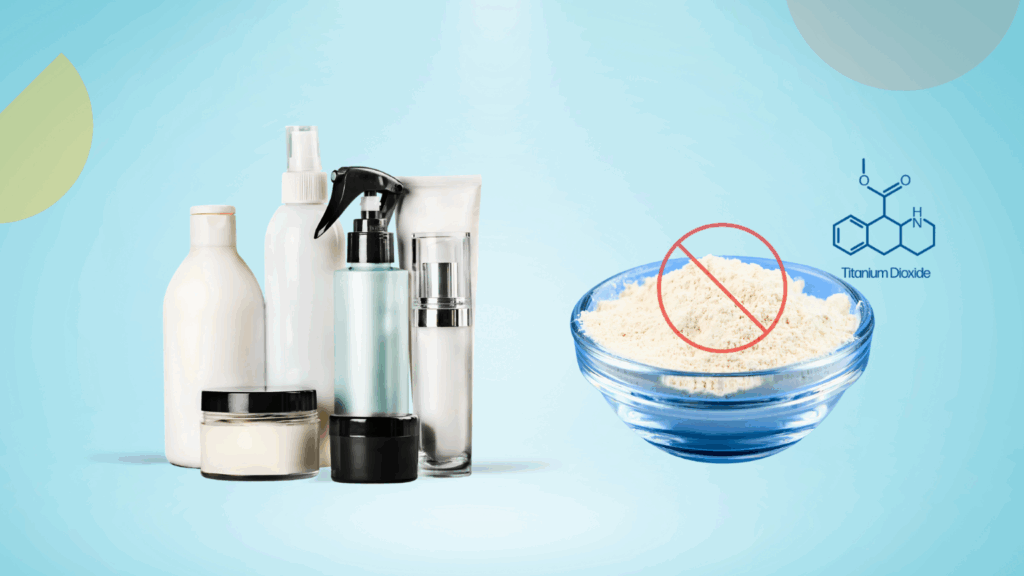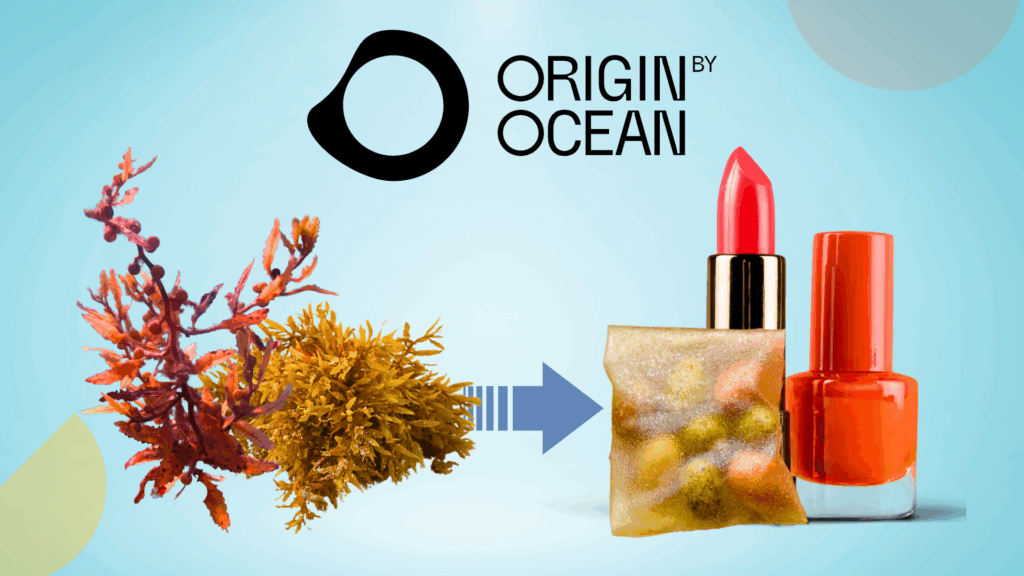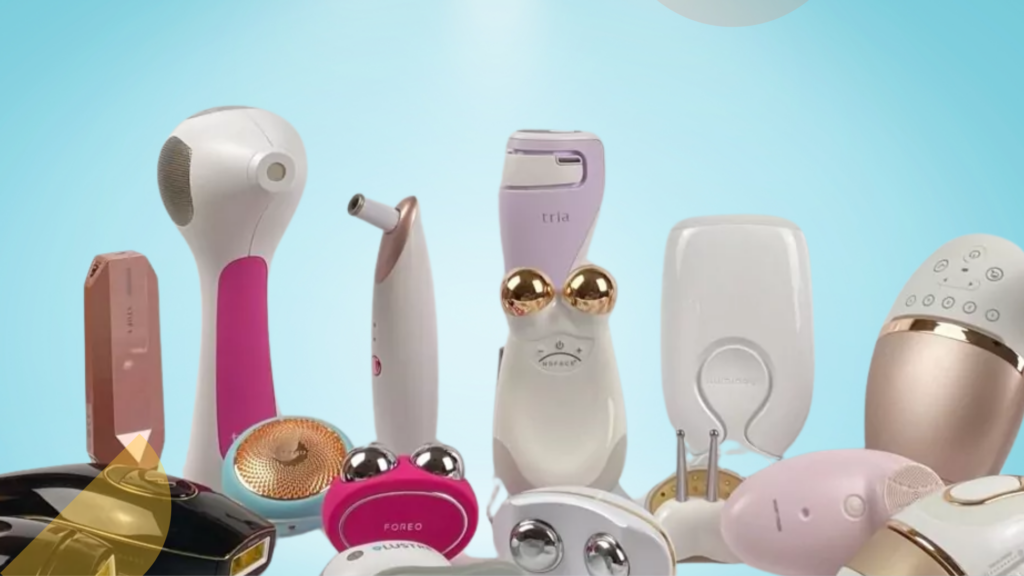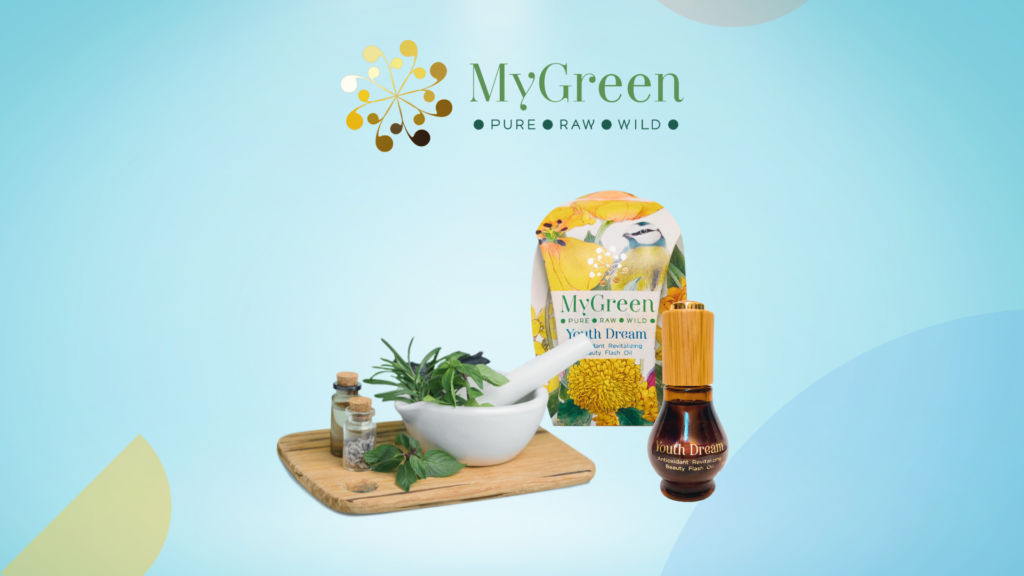Spot a trend too late, and you lose a decade chasing your competitors.
A 90-year-old beauty giant was slow to adapt to the rising trend of online shopping and social‑media marketing. Meanwhile, rivals like Kylie Cosmetics and Fenty Beauty captured the market, building direct‑to‑consumer channels and viral campaigns on Instagram and TikTok. This lack of a digital strategy led the company to file for bankruptcy in the US in 2020.
Curious about which other cosmetic industry trends can impact your business in 2026?
The 2026 beauty R&D landscape stretches far beyond lotions and lipsticks. Brands are using mushrooms to reduce stress-induced hair loss, Japanese music to enhance the functionality of probiotics, and nano-bubbles to smuggle vitamins past your skin’s defenses.
Our cosmetic trends report explores many such technologies and ingredients that will define your R&D pipelines over the next 2–3 years. We’ve analyzed 3,000+ patents, tracked emerging startups, and mapped market shifts to identify the cosmetic trends R&D teams shouldn’t miss. While our 2026 cosmetic trends report is under works, fill out the form below to get access to our 2025 Cosmetic Trends Report.
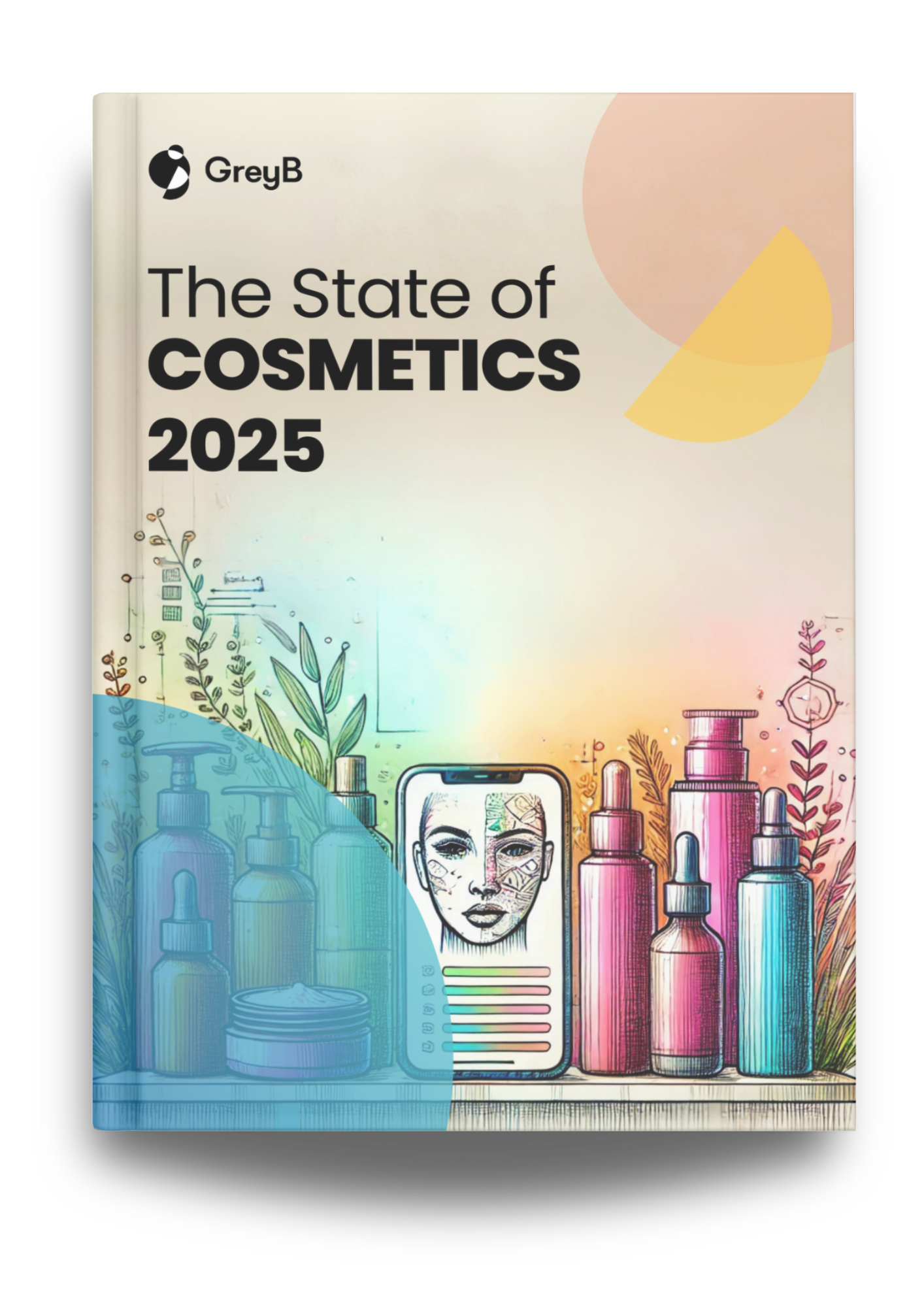
Trend 1: Neurocosmetics
This official Mintel beauty industry trend taps into the skin-brain connection. Growing wellness and self-care movements have led cosmetics brands to develop skincare products that work beyond aesthetics, enhancing users’ moods and mental well-being.
Leading ingredient suppliers in the industry, such as Croda International, Lucas Meyer Cosmetics by Clariant, Givaudan, and others, have already launched innovations in this area.
Vivienne Rudd, a Senior Consultant at Mintel, suggests that brands “create a suite of products that form a daily regimen” as they expand into this category.
Formulators are using neuroactive ingredients and adaptogens, such as ashwagandha, rhodiola, and CBD, to infuse their neurocosmetic products with calming and mood-balancing properties. However, achieving stable formulations remains a challenge. These bioactive compounds must be incorporated at concentrations that are both effective and safe for long-term skin use.
Presperse’s new ingredient targets stress-related hair loss
Presperse has introduced Inawave Polyporus, a new ingredient developed by Inabata France that targets both physical hair health and mood-related benefits.
Inawave Polyporus is derived from the sclerotia of Polyporus umbellatus, a fungus historically used in Chinese and Japanese medicine.
Clinical participants experienced a 6.3% increase in hair density, a 9.6% reduction in hairless areas, and a remarkable 20% decrease in hair fall. Additionally, they felt more relaxed and experienced a boost in self-esteem. The positive changes in self-esteem were confirmed not only through surveys but also through EEG (electroencephalogram) measurements.
Inabata France’s patented eco-extraction process underpins the development of Inawave Polyporus. The method combines microwave technology and vacuum conditions to minimize oxidation and preserve the integrity of bioactive compounds. This process is significantly faster, taking 30 minutes compared to 4.5 hours in a traditional extraction, with substantially lower energy requirements and up to 18 times fewer CO₂ emissions. It’s a gentle, low-temperature method that delivers both performance and sustainability.
The versatility of Inawave Polyporus supports broad formulation use across multiple product types, including serums, conditioners, and hair masks.
This ingredient complies with EU Regulation (EC) No. 1223/2009, Chapter V, Article 18.
Inawave Polyporus offers brands the opportunity to develop hair product lines at the intersection of scalp care and neurocosmetics.
CERTIFICATIONS & COMPLIANCE

Trend 2: Biotech-based Skincare Actives
Today’s consumers are becoming increasingly ingredient-savvy, 62% demanding sustainable and ethical alternatives in cosmetics. Beauty brands are using methods such as fermentation, engineered microorganisms, and plant cell culture to create high-performance actives in laboratories, rather than sourcing them from animals or environmentally sensitive plants.
A notable example is squalane, once derived from shark liver or olive oil. Now, biotech company Givaudan manufactures bio-squalane at scale through sugar fermentation, an ethical and scalable alternative to traditional methods.
Still, challenges remain. Scaling from lab or pilot batches to industrial production requires costly infrastructure, such as fermentation tanks and bioreactors, as well as specialized expertise. Regulatory approval and safety testing add another layer, as biotech-derived actives require thorough toxicology validation. Consumer perception also plays a role. Terms like “genetically engineered yeast” spark hesitation, so brands often emphasize natural origins and sustainability in their messaging.
Scientists are playing Japanese music to make probiotics more effective for your skincare
Xianting Guangzhou Technology R&D Co. has developed a multi-strain fermentation process that utilizes a combination of probiotics, including Bifidobacterium and Lactobacillus, to ferment black soybean milk.
The bacterial strains break down soybean proteins into smaller bioactive molecules, such as hydroxy acids, flavonoids, minerals, nucleosides, and polyamines, which are easier for the skin to absorb. These bioactive molecules can be used in cosmetic formulations to improve skin barrier function, reduce inflammation, and enhance skin vitality.
The mixture is fermented at 37°C for 5 days under agitation. Interestingly, during this time, the culture is exposed to Japanese classical music to enhance microbial activity. Tests showed that music improved metabolite yield, pH regulation, and anti-allergic properties of the probiotics compared to silent fermentation. It ensures a higher concentration of active compounds, boosting the probiotics’ performance in the skincare product.
Analyst note: Biotechnology remains misunderstood, with consumers viewing it as artificial and complex. In fact, a study revealed that 61% of consumers continue to avoid lab-grown or bioengineered actives. Therefore, educating consumers on the sustainability, safety, and performance of biotech-derived ingredients is critical for brands to expand their portfolios in the segment.
Trend 3: Waterless Cosmetics
Traditional beauty products contained 70-80% water, but sustainability concerns are now pushing brands to develop water-free formulations. Skyquest expects the market share of waterless cosmetic products to reach $ 20 billion by 2030.
Waterless products are more compact and lighter to transport, helping brands cut their carbon footprint. Industry leaders such as L’Oréal, Unilever, and P&G are rapidly expanding their IP portfolios in this space.
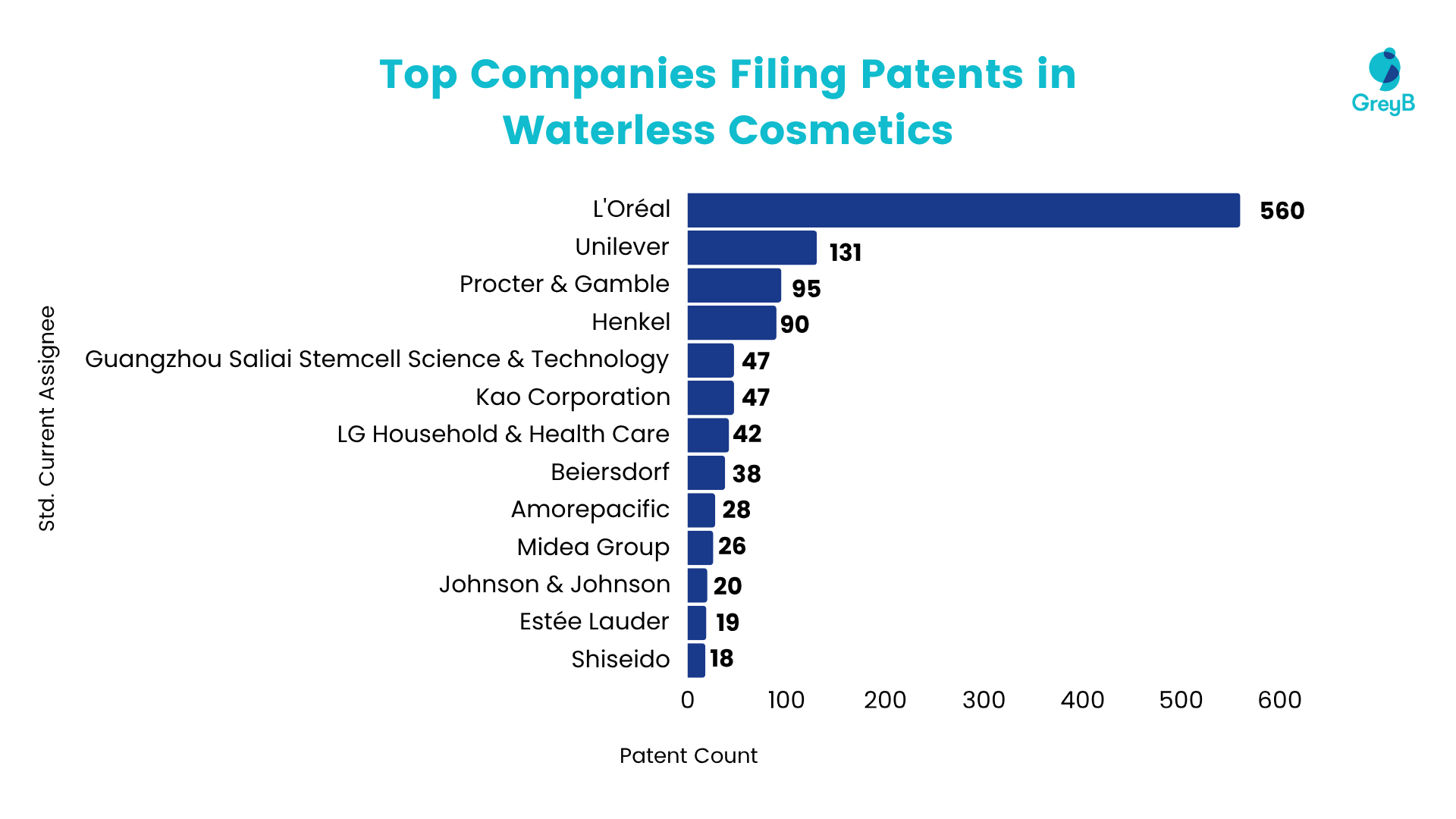
A significant challenge in expanding the market for waterless cosmetics is that ingredients like Niacinamide, Hyaluronic Acid, and Vitamin C only dissolve or activate in water. Discover how GreyB helped a leading cosmetics company to innovate in waterless cosmetics, advancing their sustainability goals.
Another hurdle is that waterless products can be difficult to apply or spread evenly, leading to user frustration. This has led formulators to develop innovative ingredient-delivery mechanisms and solvents, such as oils and waxes, to replace water’s traditional role.
High-powder formulations in hair and body care are experiencing growth. The dry shampoo market has been the fast-growing segment, driven by demand for on-the-go, convenient-to-use alternatives. Meanwhile, demand for powder-based deodorants and anti-perspirants is also rising.
However, getting dosing and dispensing right is essential for both product performance and user satisfaction. Fine particles, such as starches or silica, tend to accumulate in the dispensing mechanisms of powder-based products. These blockages compromise the user experience over time.
Aptar’s aerosol packaging seamlessly sprays high powder formulations
Aptar Beauty’s Tina collection features an aerosol valve and actuator specifically designed to dispense powder formulations with concentrations exceeding 9%. The built-in locking/unlocking system minimizes the risk of leakage in transit. This innovation eliminates the need for overcaps, which are among the top pollutants in oceans.
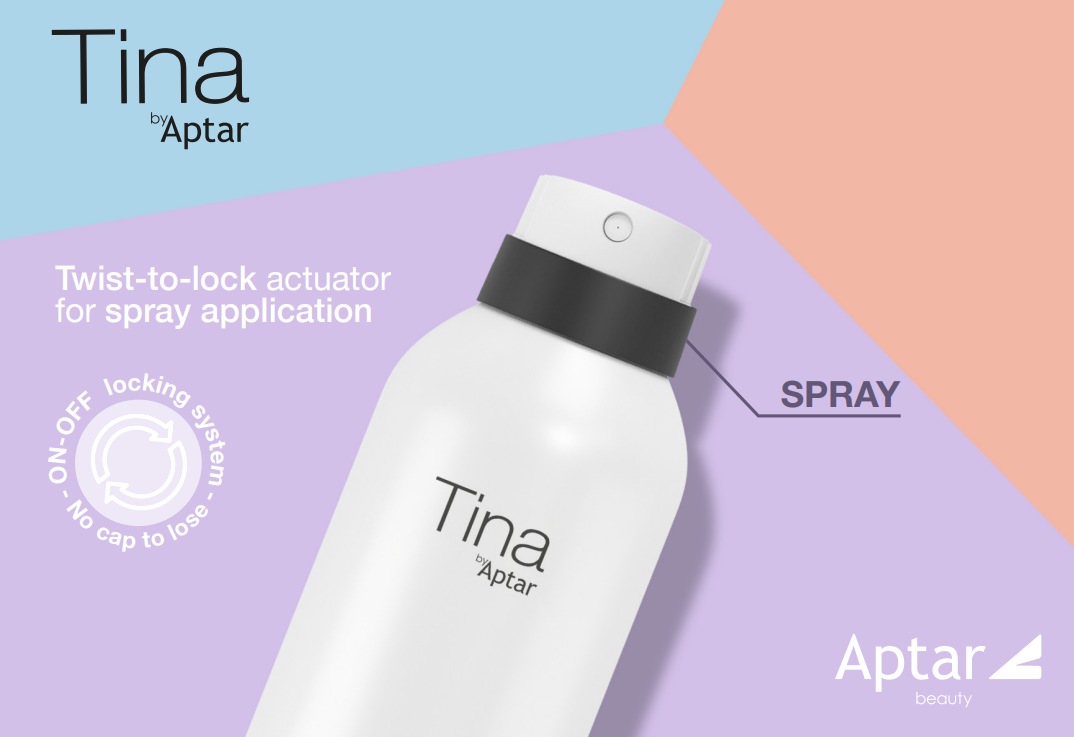
Tina features a modern design with straight and pure lines, including anti-slip ribs and a matte finish. Available in diverse color pairings, the packaging provides flexibility to showcase brand identity.
The finger recess on the cover helps users spray in the right direction, making it easier for people with visual impairments to use the product. The design also includes Aptar’s trademarked audible double-click feature for hearing-impaired users.
Tina is e-commerce-friendly. Additionally, it can be made using Post-Consumer Recycled (PCR) materials. This helps brands reduce environmental impact by minimizing the need for new, virgin plastic.
While consumers benefit from convenience, the packaging innovation gives brands the added advantage of shelf differentiation through the sleek, integrated design.
The unique design won the BAMA Aerosol Packaging Award 2024.
Reccomended Read
Trend 4: AI-based Solutions
72% of consumers are willing to pay more for customized skincare and cosmetic products. However, only 23% of brands offer such options, revealing a significant gap between consumer interest and industry offerings.
L’Oréal is capitalizing on this shift with CUSTOM D.O.S.E. The skincare service enables dermatologists to create personalized serums on the spot with lab-grade active ingredients. With over 2,000 algorithm-driven combinations, D.O.S.E ensures tailored skincare for diverse skin concerns. The final serum comes with a custom label, an expiration date, and a barcode for easy reordering.
The French beauty giant has also partnered with Nvidia to enhance its AI capabilities, enabling more accurate skin assessments and personalized product recommendations.
This isn’t all. L’Oréal is extensively working on many more customized skincare systems. Keeping up with such advancements can help R&D teams identify market gaps and capitalize on skincare innovation opportunities ahead of their competitors. Slate provides you with real-time updates on emerging technologies in your industry, helping you maintain a competitive edge. Just ask, “What are L’Oréal’s latest advancements in customized skincare?”
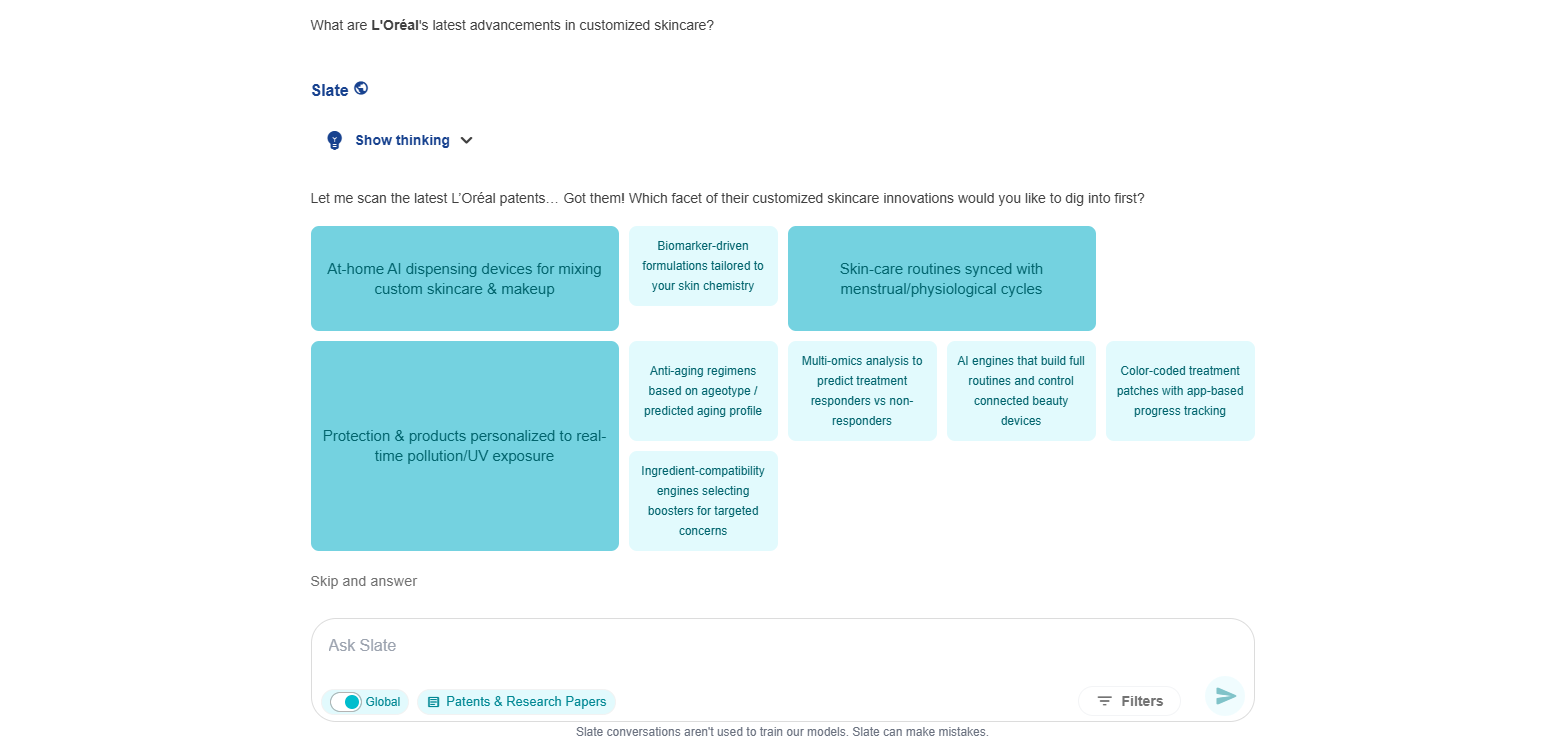
What are L’Oréal’s latest advancements in customized skincare?
Humanoid LABs’ interreality system lets users preview different looks before committing to it
Humanoid LAB’s smart cosmetic system enables users to try and apply makeup across different realities, the physical world, augmented reality (AR), and virtual reality (metaverse).
The system studies skin tone, facial features, color preferences, and occasion-specific trends to make recommendations. It can suggest real-world products to match a particular makeup style when someone uses AR or VR. Similarly, if a user applies physical makeup, the system can generate a digital version for use in virtual spaces such as social media or the metaverse.
One of the key features of this system is its ability to learn from user interactions. AI analyzes user preferences and previously selected makeup styles to recommend new ones. This feedback loop ensures a highly personalized experience.
The patent also describes an innovative cosmetic dispensing system. The system features tools such as a spray canister for airbrush effects and a pen for fine-line applications, like eyeliner. The device can monitor product volume, color, and formula, ensuring users apply the right amount of makeup without waste.
Trend 5: Nanocosmeceuticals
91% of Americans report being more ingredient-conscious than ever before. 61% say they research ingredients to ensure effectiveness, 41% to manage allergies, and 36% to compare products.
This demand for high‑efficacy products is driving the trend of nanotechnology and nanocosmeceuticals in the cosmetics industry.
Formulators are leveraging liposomes, nano‑emulsions, and nanocapsules to enhance stability, targeted delivery, photoprotection, and controlled release of actives. These technologies enable formulations that deliver multiple benefits, tailored to individual needs.
Geographically, North America currently dominates the market, driven by high consumer awareness and purchasing power. However, Asia-Pacific is emerging as the fastest-growing region due to its tech‑savvy population seeking anti-aging and skin‑brightening products. Discover how GreyB identified whitespace opportunities to expand in the anti-aging cosmetics market.
Xinzhijie Suzhou Biotechnology’s approach uses liposome technology to deliver multiple benefits in a single solution
Traditional skincare formulations often mix active ingredients into simple blends. While convenient, this approach can result in compositions with poor absorption and skin irritation.
Many active compounds, such as retinol, niacinamide, and peptides, are unstable in simple formulations. They tend to degrade when exposed to light, oxygen, or heat. As a result, traditional cosmetics often lose effectiveness before delivering the desired benefits. Additionally, consumers look for solutions that offer multiple benefits in a single, reliable product.
Xinzhijie Suzhou Biotechnology addresses these challenges through its innovative liposome technology. Liposomes are tiny, bubble-like carriers that encapsulate active ingredients, protecting them from degradation while delivering them deep into the skin. This technology ensures the stability of actives in the product and their higher bioavailability. The approach allows for controlled release of actives, reducing the risk of irritation.
The patented formulation combines a balanced mix of protein peptides for repair and elasticity, vitamins for nourishment and brightening, hyaluronic acid for deep hydration, antioxidants for anti-aging, and lipids to strengthen the skin barrier. By combining these elements, the technology provides multiple skincare benefits in a single solution.
Conclusion
Menopause and hormonal beauty solutions, microbiome-friendly skincare, and beauty devices that give salon-like treatments at home are also creating a buzz in the industry.
While these trends are exciting, are they scalable?
Legal experts warn that regulatory scrutiny is shifting from food to cosmetics, with increased focus on ingredients, packaging materials, and full lifecycle compliance. This means R&D heads must do more than chase trends—they must evaluate each innovation for regulatory compliance, cost efficiency, and long-term sustainability before betting on it.
GreyB can help you assess which solutions are viable, scalable, and compliant. Fill out the form and talk to our expert.
How Can We Help You?
We support industry-leading R&D and Innovation professionals through complex problems. Describe your challenge, and let us bring clarity and expertise.

